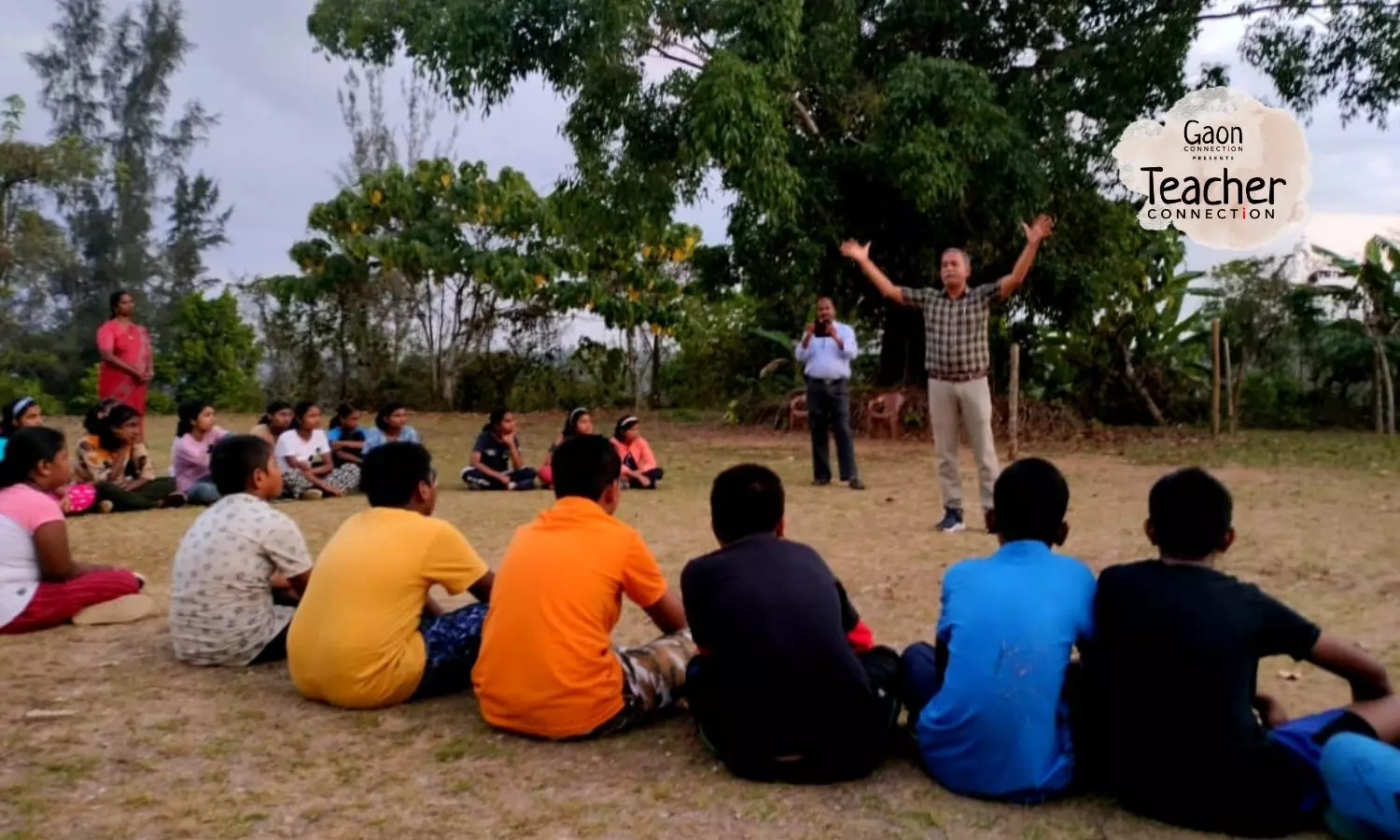A Science Teacher In The Andaman Islands Is Making His Students ‘Conservators’
A science teacher in north and middle Andaman trains his students to map natural resources and identify ecological hotspots for conservation
 Laraib Fatima Warsi 14 Sep 2023 1:00 PM GMT
Laraib Fatima Warsi 14 Sep 2023 1:00 PM GMT

A science teacher finds ways to connect his students with their local environment on the islands — the forests, river systems, and wildlife. All Photographs by Chanchal Singha Roy.
Mohit Kumar Roy knows all about the mangrove forests in Andaman and Nicobar Islands. The 15-year-old son of a local plumber can also list down names of all the rivers in the islands in no time.
“Chanchal sir makes us do various projects on biodiversity, nature and wildlife conservation. He also organises skits in the school so as to make us understand the topics,” the student of Government Senior Secondary School in Kadamtala village of Rangat tehsil of north and middle Andaman, told Gaon Connection. The village is located 77 kilometres from Port Blair.
I follow a place-based approach which includes things like mapping natural resources, and projects that help them understand their environment, said Roy
Chanchal Singha Roy, a general science teacher at the school, constantly finds ways to connect his students, most of whom come from economically weaker and marginalised communities, with their local environment on the islands — the forests, river systems, and wildlife. Conservation of the islands’ rich biodiversity is the 53-year-old teacher’s priority.
“Andaman and Nicobar Islands are rich in biodiversity but they also need to be protected by those who live here. Most of the students who study in our school belong to fisher families. I follow a place-based approach which includes things like mapping natural resources, and projects that help them understand their environment in a better way,” Roy told Gaon Connection.
Having lived in the Andaman and Nicobar Islands for three generations now, Roy feels blessed to be teaching at a rural school in India’s most remote Union Territory.
Also Read: Gaon Connection Founder Neelesh Misra Pens A Heartfelt Note On Teacher Connection’s Book Launch
“My father was also a teacher and so is my wife. There has always been an academic environment in my family,” told Roy.
The school where he teaches has classes from Nursery to Class 12 with an estimated student strength of 500. Roy teaches science to classes six to tenth. The school was established in 1979 and Roy has been teaching here since 2018.
Roy has taught the students to map their villages, identify the ecological hotspots and mark out areas that need environmental care and protection.
Roy organises open-air classes in the village to reach out to more children and help them develop an interest in science.
“This way I tend to create a healthy relationship with my students and also make the class interactive,” said Roy.
Roy’s teaching methods have ensured children from far flung villages come to the school to study. For instance, 12-year-old Aditya Ram, a student of class five, daily walks five kilometres through the forest, to come to school to study.
Also Read: Use Of Bluetooth And Puppets In The Classroom Makes Learning Fun In A Govt School
“I also daily cross a small stream whose bridge is broken. It is sometimes scary but what I learn at the school makes me want to take this path to reach school,” Ram told Gaon Connection. “I want to grow up to become a teacher like Roy sir,” he added.
Mohit Kumar, the 15-year-old student of class 10th, lives in Kadamtala village, around two kilometres from the school. “We have made a big map of the science centre at our school. Mapping also helps us understand the different areas of the village. We have also learned about mangrove ecosystems and various names of the rivers situated in our union territory”.
Meanwhile, Roy, the teacher, hasn’t kept teaching limited to the classroom alone. He regularly conducts outdoor activities. “I organise these activities and games based on nature, forest conservation and diversity. I also give them the chance to explore their skills and learn photography so that their studies do not seem boring to them,” he further explained.
Also Read: Bringing the girls back to school
On Sundays and other holidays, Roy organises open-air classes in the village to reach out to more children and help them develop an interest in science.
He teaches his students about biodiversity, and how to map their natural resources.
“I along with some other teachers go to the remote villages of the students to organise science lectures and presentations on Sundays. We show videos and teach them about biodiversity, and how to map their natural resources,” Roy added.
Bithika Bairagi, a 13-year-old girl and a student of class eight, loves studying English and lives in Uttara village of Rangat block in north and middle Andaman. “I enjoy reading English poems and stories. I like to learn new words in English,” she told Gaon Connection.
Bairagi’s father Barun Bairagi, a 36-year-old fisher, earns Rs 300-Rs 500 on a daily basis.
“We are bearing the brunt of an increase in inflation and recurring cyclones because of which I cannot go fishing and there is no earning,” Bairagi told Gaon Connection.
“I have two children, but I will not stop them from studying. I will keep sending them to the school as Roy sir guides them in every possible way and has been a big support to all the children in the school,” the father added.
TeacherConnection #Andaman&Nicobar #eduction
More Stories




